Effect of Temperature on Isolation and Characterization of Hydroxyapatite from Tuna (Thunnus obesus) Bone
Abstract
:1. Introduction
2. Results and Discussion
2.1. General Description
| Sample no. | Calcination Temperature (°C) | Calcination Period in (h) | Initial Weight (g) | After calcination (g) | Residue (%) | Description |
|---|---|---|---|---|---|---|
| 1 | 1200 | 5 | 2.0000 | 1.1527 | 57.6350 | white |
| 2 | 1100 | 5 | 2.0020 | 1.1529 | 57.5874 | white |
| 3 | 1000 | 5 | 2.0024 | 1.1771 | 58.7845 | white |
| 4 | 900 | 5 | 2.0011 | 1.1872 | 59.3274 | white |
| 5 | 800 | 5 | 2.0030 | 1.1936 | 59.5906 | white |
| 6 | 700 | 5 | 2.0032 | 1.2129 | 60.5481 | off white |
| 7 | 600 | 5 | 2.0017 | 1.2434 | 62.1172 | off white |
| 8 | 500 | 5 | 2.0052 | 1.2688 | 63.2755 | Tanish |
| 9 | 400 | 5 | 2.0031 | 1.3402 | 66.9063 | Tanish |
| 10 | 300 | 5 | 2.0061 | 1.5162 | 75.5795 | Black |
| 11 | 200 | 5 | 2.0000 | 1.7360 | 86.8000 | Black |
| 12 | Raw fish bone | - | - | - | - | Yellow |
2.2. Thermal Analysis of Thunnus obesus Bone
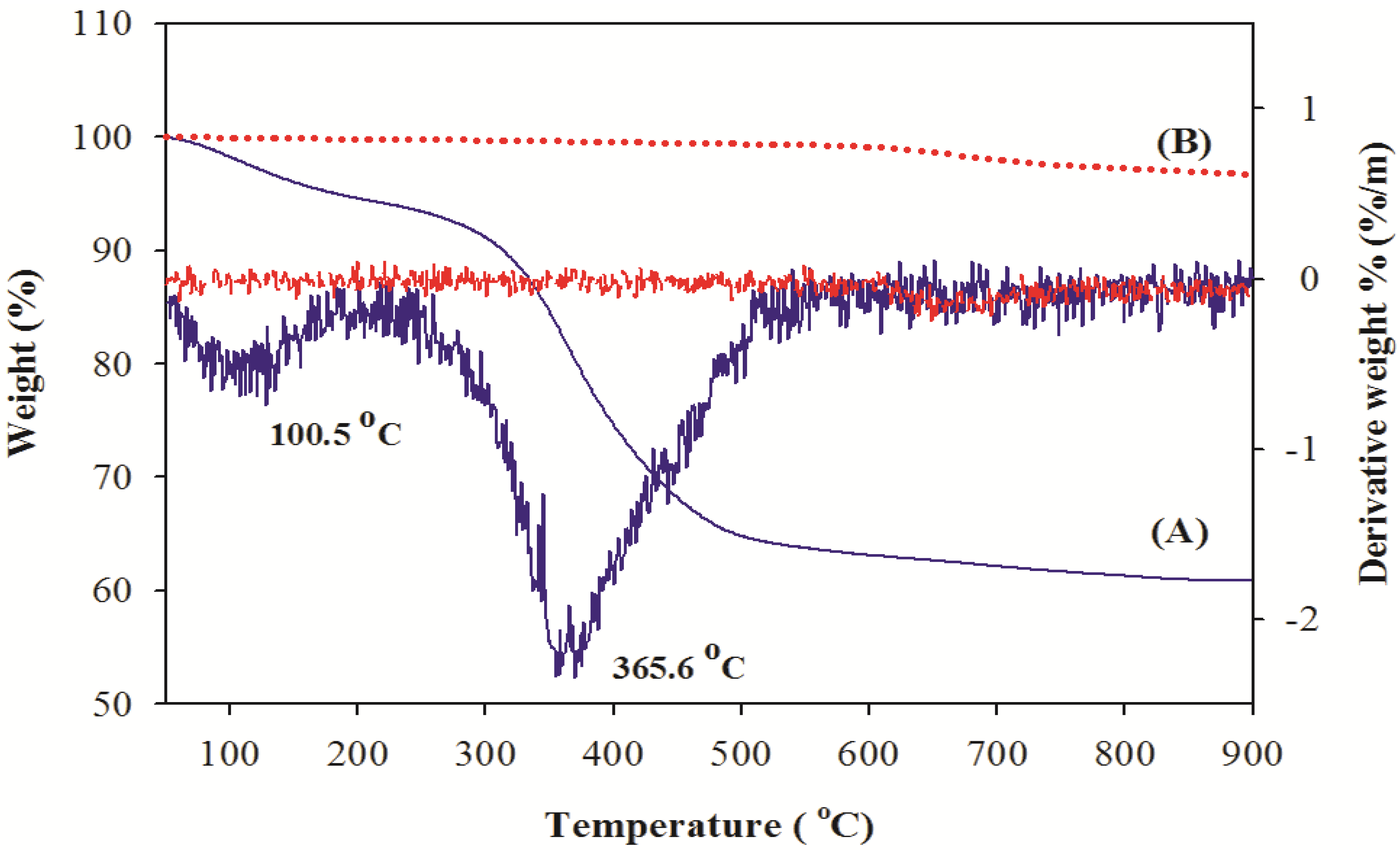
2.3. FT-Infrared Spectroscopic Analysis

2.4. X-Ray Diffraction Analysis of Thunnus obesus Bone
| h k l | d-spacing (nm) | Position (2θ) | Intensity (%) | ||||||||||||
|---|---|---|---|---|---|---|---|---|---|---|---|---|---|---|---|
| JCPDS | 700 °C | 800 °C | 900 °C | 1000 °C | JCPDS | 700 °C | 800 °C | 900 °C | 1000 °C | JCPDS | 700 ° C | 800 °C | 900 °C | 1000°C | |
| 0 0 2 | 0.344 | 0.341 | 0.342 | 0.343 | 0.342 | 25.87 | 26.11 | 26.08 | 26.01 | 25.98 | 40 | 29.9 | 34.6 | 29.2 | 27.5 |
| 2 1 1 | 0.281 | 0.279 | 0.280 | 0.280 | 0.280 | 31.77 | 32.05 | 32.00 | 31.91 | 31.89 | 100 | 100 | 100 | 100 | 100 |
| 1 1 2 | 0.278 | 0.275 | 0.276 | 0.277 | 0.277 | 32.19 | 32.45 | 32.41 | 32.34 | 32.32 | 60 | 49.1 | 56.9 | 48.3 | 40.1 |
| 3 0 0 | 0.272 | 0.269 | 0.270 | 0.271 | 0.271 | 32.90 | 33.19 | 33.14 | 33.06 | 33.04 | 60 | 85.2 | 84.4 | 77.4 | 71.2 |
| 2 0 2 | 0.263 | 0.261 | 0.262 | 0.262 | 0.262 | 34.04 | 34.32 | 34.27 | 34.23 | 34.19 | 25 | 24.6 | 28 | 23.5 | 19.6 |
| 3 1 0 | 0.226 | 0.224 | 0.225 | 0.226 | 0.225 | 39.81 | 39.47 | 39.39 | 39.96 | 39.93 | 20 | 27.9 | 26.8 | 30 | 25.5 |
| 2 1 3 | 0.184 | 0.183 | 0.184 | 0.184 | 0.183 | 49.46 | 49.71 | 49.69 | 49.63 | 49.85 | 40 | 26.3 | 29.3 | 28.2 | 23.9 |
| Error | 0.047 | 0.038 | 0.024 | 0.019 | 0.056 | 0.051 | 0.031 | 0.031 | 1.6 | 1.3 | 1.7 | 1.7 | |||
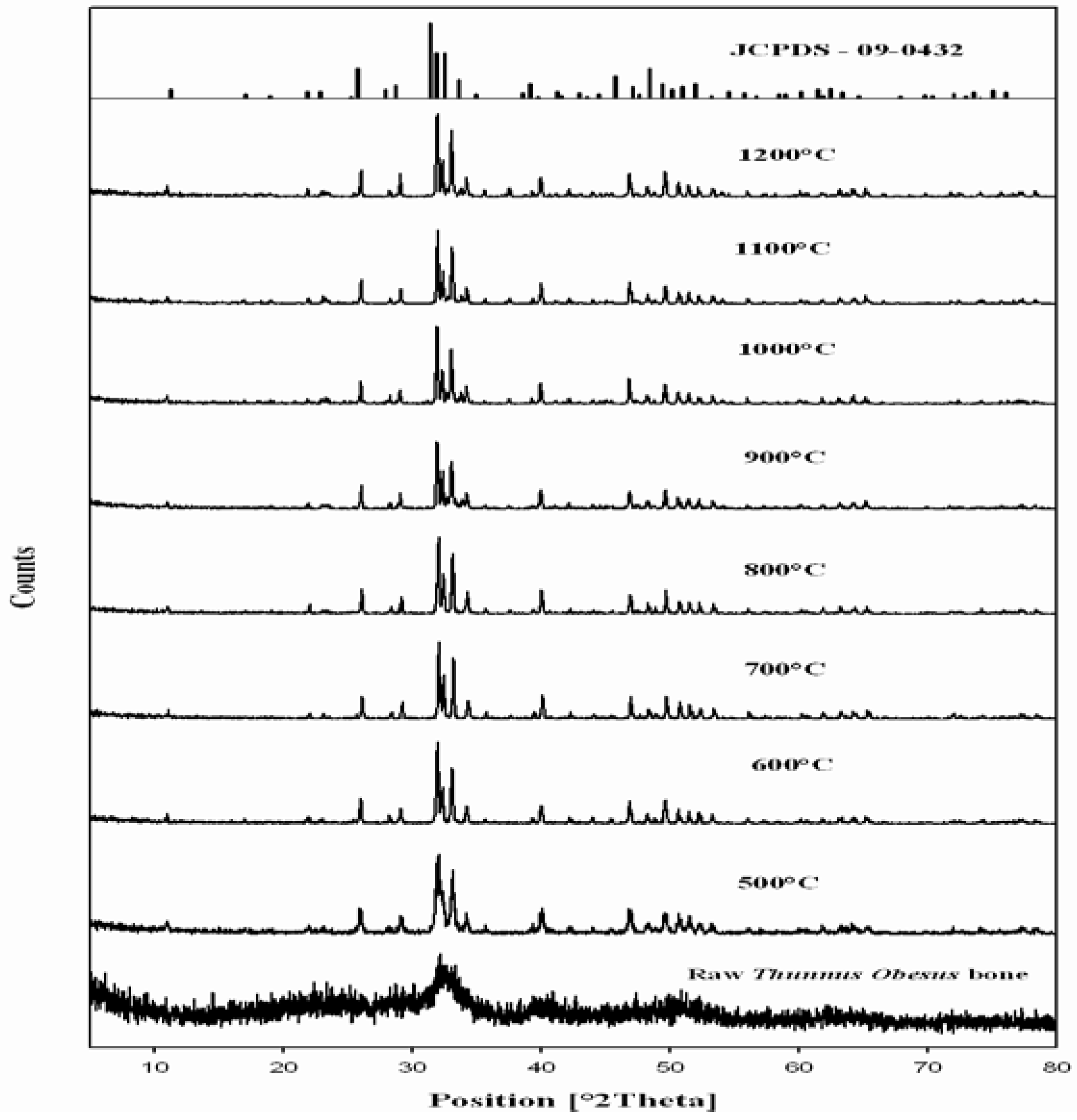
2.5. Field Emission-Scanning Electron Microscope Analysis
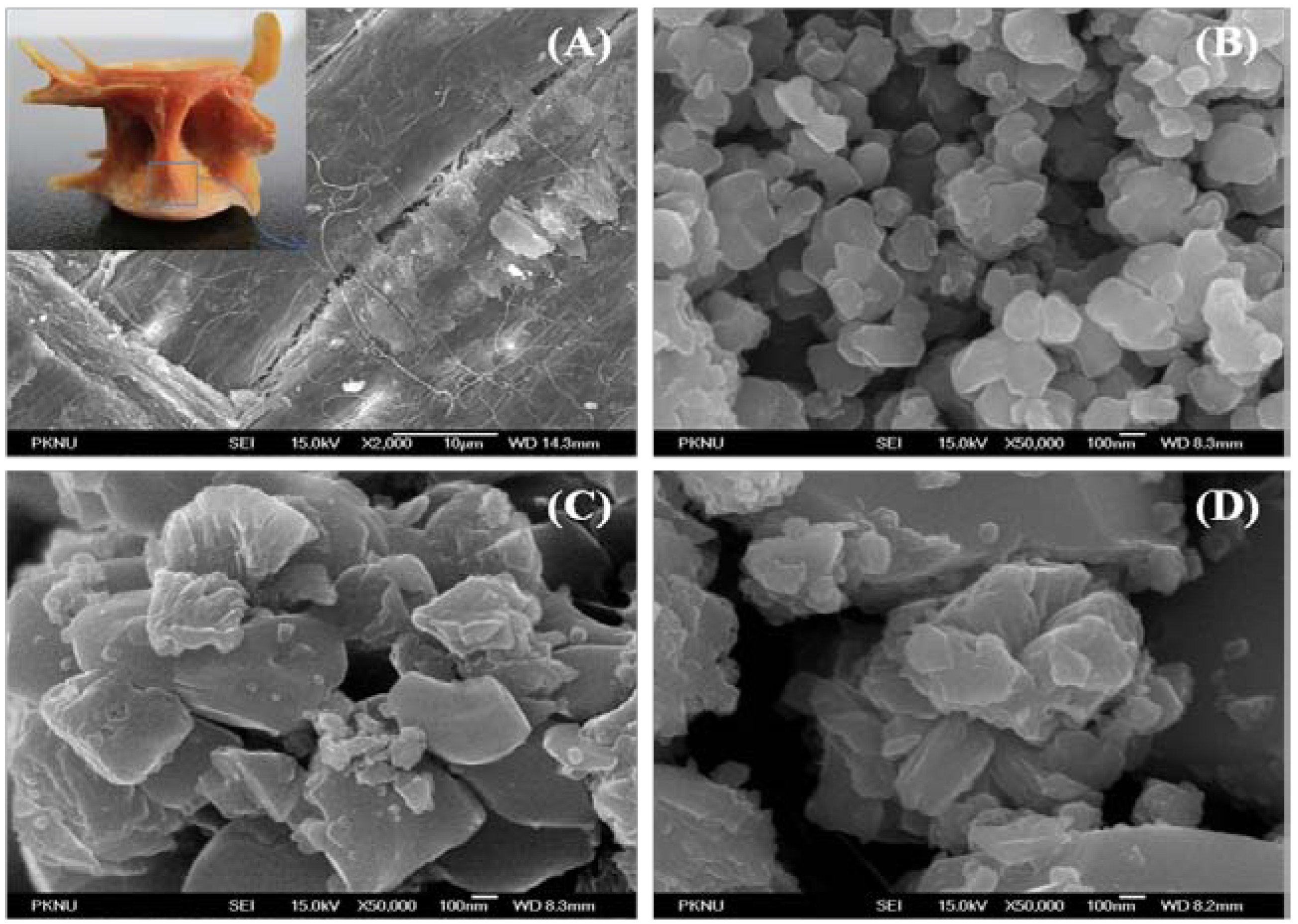
2.6. Electron Dispersive X-ray Analysis
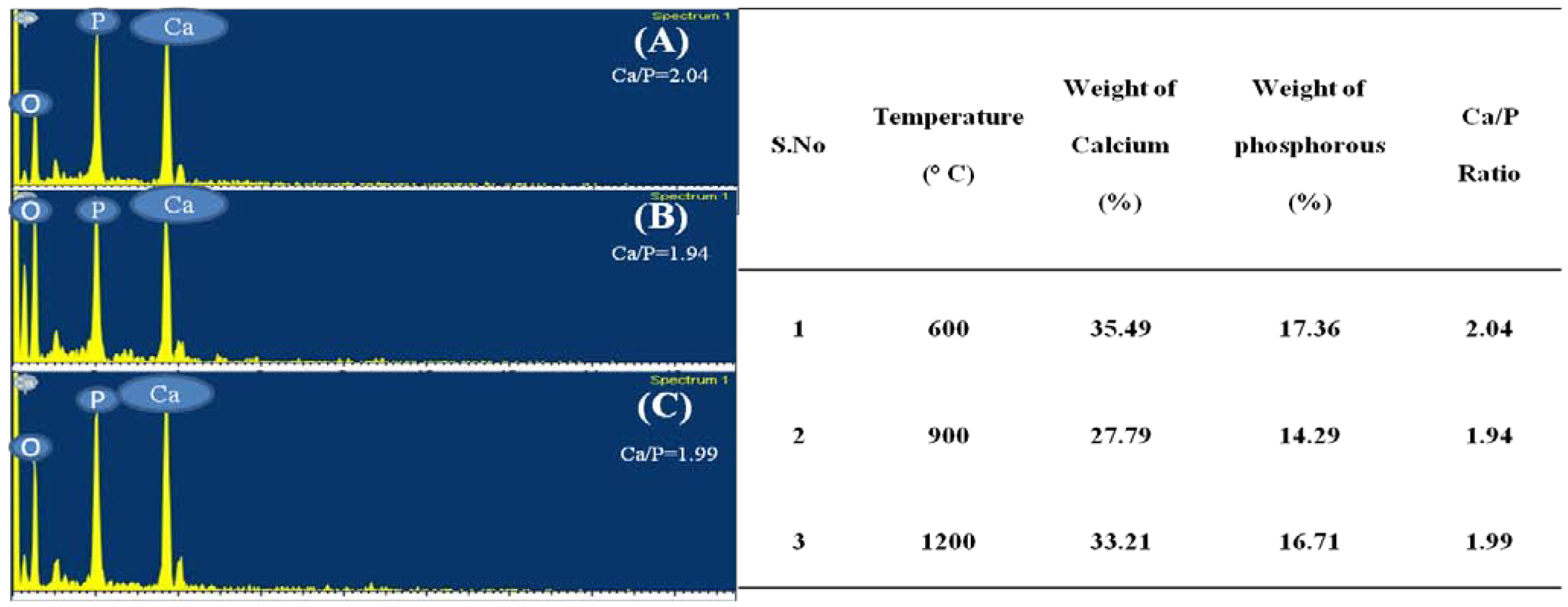
2.7. Cytotoxicity Assay
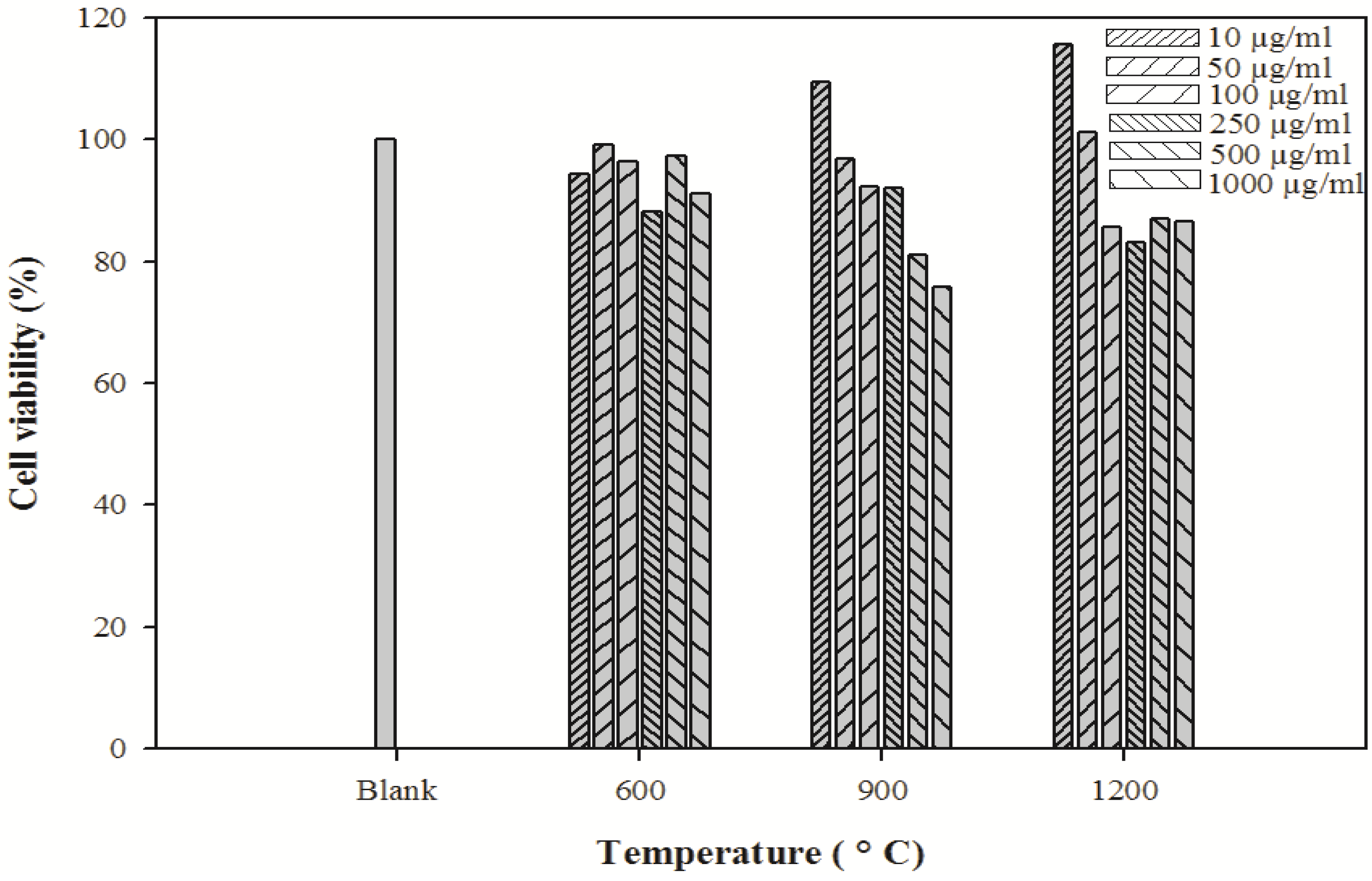
3. Experimental Section
3.1. Sample Preparation
3.2. Characterization
4. Conclusion
Acknowledgements
References
- Fratzl, P.; Gupta, H.; Paschalis, E.; Roschger, P. Structure and mechanical quality of the collagen–mineral nano-composite in bone. J. Mater. Chem. 2004, 14, 2115–2123. [Google Scholar] [CrossRef]
- Tang, P.; Li, G.; Wang, J.; Zheng, Q.; Wang, Y. Development, characterization, and validation of porous carbonated hydroxyapatite bone cement. J. Biomed. Mater. Res. B 2009, 90, 886–893. [Google Scholar] [CrossRef]
- Staffa, G.; Nataloni, A.; Compagnone, C.; Servadei, F. Custom made cranioplasty prostheses in porous hydroxyapatite using 3D design techniques: 7 years experience in 25 patients. Acta Neurochir. 2007, 149, 161–170. [Google Scholar] [CrossRef] [PubMed]
- Nair, M.; Suresh Babu, S.; Varma, H.; John, A. A triphasic ceramic-coated porous hydroxyapatite for tissue engineering application. Acta Biomater. 2008, 4, 173–181. [Google Scholar] [CrossRef] [PubMed]
- Hirata, A.; Maruyama, Y.; Onishi, K.; Hayashi, A.; Saze, M.; Okada, E. A Vascularized artificial bone graft using the periosteal fflap and porous hydroxyapatite; basic research and preliminary clinical application. Wound Repair Regen. 2008, 12, A4. [Google Scholar] [CrossRef]
- Venkatesan, J.; Kim, S.-K. Chitosan composites for bone tissue engineering—an overview. Mar. Drugs 2010, 8, 2252–2266. [Google Scholar] [CrossRef] [PubMed]
- Venkatesan, J.; Qian, Z.J.; Ryu, B.; Ashok Kumar, N.; Kim, S.K. Preparation and characterization of carbon nanotube-grafted-chitosan—Natural hydroxyapatite composite for bone tissue engineering. Carbohyd. Polym. 2010. [Google Scholar] [CrossRef]
- Salman, S.; Soundararajan, S.; Safina, G.; Satoh, I.; Danielsson, B. Hydroxyapatite as a novel reversible in situ adsorption matrix for enzyme thermistor-based FIA. Talanta 2008, 77, 490–493. [Google Scholar] [CrossRef]
- Reichert, J.; Binner, J. An evaluation of hydroxyapatite-based filters for removal of heavy metal ions from aqueous solutions. J. Mater. Sci. 1996, 31, 1231–1241. [Google Scholar] [CrossRef]
- Kano, S.; Yamazaki, A.; Otsuka, R.; Ohgaki, M.; Akao, M.; Aoki, H. Application of hydroxyapatite-sol as drug carrier. Bio-Med. Mater. Eng. 1994, 4, 283. [Google Scholar]
- Zhang, H.; Zhou, K.; Li, Z.; Huang, S. Plate-like hydroxyapatite nanoparticles synthesized by the hydrothermal method. J. Phys. Chem. Solids 2009, 70, 243–248. [Google Scholar] [CrossRef]
- Chen, J.; Wang, Y.; Wei, K.; Zhang, S.; Shi, X. Self-organization of hydroxyapatite nanorods through oriented attachment. Biomaterials 2007, 28, 2275–2280. [Google Scholar] [CrossRef] [PubMed]
- Jarudilokkul, S.; Tanthapanichakoon, W.; Boonamnuayvittaya, V. Synthesis of hydroxyapatite nanoparticles using an emulsion liquid membrane system. Colloid. Surface. A 2007, 296, 149–153. [Google Scholar] [CrossRef]
- Sarig, S.; Kahana, F. Rapid formation of nanocrystalline apatite. J. Cryst. Growth 2002, 237, 55–59. [Google Scholar] [CrossRef]
- Monmaturapoj, N. Nano-size Hydroxyapatite Powders Preparation by Wet-Chemical Precipitation Route. J. Met. Mater. Miner. 2008, 18, 15–20. [Google Scholar]
- Xu, J.; Khor, K.; Dong, Z.; Gu, Y.; Kumar, R.; Cheang, P. Preparation and characterization of nano-sized hydroxyapatite powders produced in a radio frequency (rf) thermal plasma. Mater. Sci. Eng. A 2004, 374, 101–108. [Google Scholar] [CrossRef]
- Cao, L.; Zhang, C.; Huang, J. Synthesis of hydroxyapatite nanoparticles in ultrasonic precipitation. Ceram. Int. 2005, 31, 1041–1044. [Google Scholar] [CrossRef]
- Guo, G.; Sun, Y.; Wang, Z.; Guo, H. Preparation of hydroxyapatite nanoparticles by reverse microemulsion. Ceram. Int. 2005, 31, 869–872. [Google Scholar] [CrossRef]
- Simon, V.; Lazar, D.; Turcu, R.; Mocuta, H.; Magyari, K.; Prinz, M.; Neumann, M.; Simon, S. Atomic environment in sol–gel derived nanocrystalline hydroxyapatite. Mater. Sci. Eng. B 2009, 165, 247–251. [Google Scholar] [CrossRef]
- Liu, D.; Yang, Q.; Troczynski, T.; Tseng, W. Structural evolution of sol–gel-derived hydroxyapatite. Biomaterials 2002, 23, 1679–1687. [Google Scholar] [CrossRef] [PubMed]
- Feng, W.; Mu-Sen, L.; Yu-Peng, L.; Yong-Xin, Q. A simple sol–gel technique for preparing hydroxyapatite nanopowders. Mater. Lett. 2005, 59, 916–919. [Google Scholar] [CrossRef]
- Tseng, Y.; Kuo, C.; Li, Y.; Huang, C. Polymer-assisted synthesis of hydroxyapatite nanoparticle. Mater. Sci. Eng. C 2009, 29, 819–822. [Google Scholar] [CrossRef]
- Farley, J.; Clear, N.; Leroy, B.; Davis, T.; Mcpherson, G. Age, growth and preliminary estimates of maturity of bigeye tuna, Thunnus obesus, in the Australian region. Mar. Freshwater Res. 2006, 57, 713–724. [Google Scholar] [CrossRef]
- Cho, S.; Gu, Y.; Kim, S. Extracting optimization and physical properties of yellowfin tuna (Thunnus albacares) skin gelatin compared to mammalian gelatins. Food Hydrocolloid. 2005, 19, 221–229. [Google Scholar] [CrossRef]
- Ozawa, M.; Satake, K.; Suzuki, R. Removal of aqueous chromium by fish bone waste originated hydroxyapatite. J. Mater. Sci. Lett. 2003, 22, 513–514. [Google Scholar] [CrossRef]
- Ozawa, M.; Suzuki, S. Microstructural development of natural hydroxyapatite originated from fish-bone waste through heat treatment. J. Am. Ceram. Soc. 2002, 85, 1315–1317. [Google Scholar] [CrossRef]
- Haberko, K.; Bu ko, M.; Brzezi ska-Miecznik, J.; Haberko, M.; Mozgawa, W.; Panz, T.; Pyda, A.; Zar bski, J. Natural hydroxyapatite—its behaviour during heat treatment. J. Eur. Ceram. Soc. 2006, 26, 537–542. [Google Scholar] [CrossRef]
- Barakat, N.; Khil, M.; Omran, A.; Sheikh, F.; Kim, H. Extraction of pure natural hydroxyapatite from the bovine bones bio waste by three different methods. J. Mater. Process. Tech. 2009, 209, 3408–3415. [Google Scholar] [CrossRef]
- Joschek, S.; Nies, B.; Krotz, R.; Göpferich, A. Chemical and physicochemical characterization of porous hydroxyapatite ceramics made of natural bone. Biomaterials 2000, 21, 1645–1658. [Google Scholar] [CrossRef] [PubMed]
- Ooi, C. Y.; Hamdi, M.; Ramesh, S. Properties of hydroxyapatite produced by annealing of bovine bone. Ceram. Int. 2007, 33, 1171–1177. [Google Scholar] [CrossRef]
- Dachun, L.; Wei, C. Preparation and characterization of natural hydroxyapatite from animal hard tissues. Key Eng. Mat. 2007, 342, 343. [Google Scholar]
- Ivankovic, H.; Gallego Ferrer, G.; Tkalcec, E.; Orlic, S.; Ivankovic, M. Preparation of highly porous hydroxyapatite from cuttlefish bone. J. Mater. Sci.-Mater. Med. 2009, 20, 1039–1046. [Google Scholar] [CrossRef] [PubMed]
- Kim, S.; Park, P.; Kim, Y. Study on acute subcutaneous toxicity of hydroxyapatite sinter produced from tuna bone in Sprague—Dawly rats. Korean J. Life Sci. 2001, 11, 97–102. [Google Scholar]
- Walters, M.; Leung, Y.; Blumenthal, N.; LeGeros, R.; Konsker, K. A Raman and infrared spectroscopic investigation of biological hydroxyapatite. J. Inorg. Biochem. 1990, 39, 193. [Google Scholar] [CrossRef] [PubMed]
- Koutsopoulos, S. Synthesis and characterization of hydroxyapatite crystals: A review study on the analytical methods. J. Biomed. Mater. Res. 2002, 62, 600–612. [Google Scholar] [CrossRef] [PubMed]
- Glimcher, M. J. Molecular biology of mineralized tissues with particular reference to bone. Rev. Mod. Phys. 1959, 31, 359. [Google Scholar] [CrossRef]
- Wang, P.; Chaki, T. Sintering behaviour and mechanical properties of hydroxyapatite and dicalcium phosphate. J. Mater. Sci.-Mater. Med. 1993, 4, 150–158. [Google Scholar] [CrossRef]
- Han, Y.; Li, S.; Wang, X.; Jia, L.; He, J. Preparation of hydroxyapatite rod-like crystals by protein precursor method. Mater. Res. Bull. 2007, 42, 1169–1177. [Google Scholar] [CrossRef]
© 2010 by the authors; licensee MDPI, Basel, Switzerland. This article is an open access article distributed under the terms and conditions of the Creative Commons Attribution license (http://creativecommons.org/licenses/by/3.0/).
Share and Cite
Venkatesan, J.; Kim, S.K. Effect of Temperature on Isolation and Characterization of Hydroxyapatite from Tuna (Thunnus obesus) Bone. Materials 2010, 3, 4761-4772. https://doi.org/10.3390/ma3104761
Venkatesan J, Kim SK. Effect of Temperature on Isolation and Characterization of Hydroxyapatite from Tuna (Thunnus obesus) Bone. Materials. 2010; 3(10):4761-4772. https://doi.org/10.3390/ma3104761
Chicago/Turabian StyleVenkatesan, Jayachandran, and Se Kwon Kim. 2010. "Effect of Temperature on Isolation and Characterization of Hydroxyapatite from Tuna (Thunnus obesus) Bone" Materials 3, no. 10: 4761-4772. https://doi.org/10.3390/ma3104761




